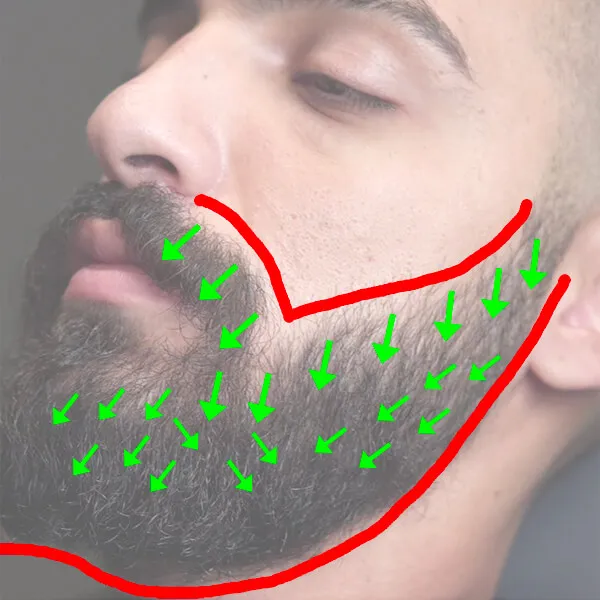Beard Transplants Dallas
Revolutionizing Facial Symmetry with SmartGraft FUE
In this day and age, where facial hair plays a significant role in defining one's persona, the demand for fuller, well-groomed beards has never been higher.
SmartGraft FUE: The Vanguard of Beard Hair Restoration
At the forefront of this transformative journey is the SmartGraft Follicular Unit Extraction (FUE) technology, a beacon of innovation in beard hair transplants.
This cutting-edge method is a stark contrast to traditional hair transplantation techniques. By meticulously extracting individual hair follicles, SmartGraft FUE offers a precise and minimally invasive approach to beard hair restoration.
This advanced technology caters to those seeking natural-looking beard hair growth, aiming to enhance their facial hair or even conceal areas affected by thinning hair or scarring.
Facial Hair Restoration: Crafting Natural Aesthetics
Facial hair restoration, particularly through beard transplants, is more than just a cosmetic procedure; it's an art form.
It involves a detailed understanding of facial structure, hair growth patterns, and aesthetic proportions.
The procedure is tailored to each individual, ensuring that the beard hair, once transplanted, blends seamlessly with the existing facial hair, promoting natural hair growth and enhancing one's facial features.
The SmartGraft FUE technique takes this a notch higher by ensuring minimal downtime and reduced scarring compared to conventional methods.
It's a testament to the evolving landscape of beard hair transplantation, where technology meets artistry to redefine facial contours.

BOOK NOW
Using this form to book a consultation is the fastest way to ensure your enquiry reaches the best person in our team as quickly as possible.
Setting the Stage for Transformation
As we delve deeper into the world of beard transplants in Dallas, we will explore various facets of this remarkable procedure.
From understanding the intricate process of follicular unit extraction to unraveling the benefits and considerations of undergoing a beard hair transplant, this guide serves as your comprehensive companion in your journey toward achieving the perfect beard.
Beard Hair Transplants: Processes & Techniques

Understanding the Beard Hair Transplant Procedure
Embarking on a beard hair transplant journey involves a comprehensive understanding of the process, especially for those contemplating this transformative step.
As a potential patient, it’s crucial to grasp the nuances of facial hair transplant techniques, particularly the science behind hair follicle extraction and transplantation.
FUE vs. FUT: A Comparative Insight
Beard hair transplantation primarily employs two techniques: Follicular Unit Extraction (FUE) and Follicular Unit Transplantation (FUT).
The FUE procedure, renowned for its precision and minimal scarring, involves extracting individual hair follicles from the donor area, typically the back of the scalp.
These follicles are then meticulously transplanted into the beard area, fostering natural hair growth and enhancing facial hair density.
Conversely, FUT, though less commonly used for beard transplants, involves removing a strip of skin from the donor area.
The hair follicles are then separated and transplanted. While FUT can be efficient in harvesting a large number of grafts, it’s more invasive than FUE and may result in a linear scar at the donor site.
The Science Behind Follicular Transplantation
The success of a beard hair transplant hinges on the survivability of transplanted hairs. Advanced techniques like FUE ensure the high viability of hair grafts, allowing for natural-looking beard hair growth.
Each graft, containing a few hair follicles, is carefully placed to mimic the natural growth pattern of facial hair. This attention to detail is crucial in achieving a natural look and ensuring that the transplanted hair integrates seamlessly with existing facial hair.

Ensuring Hair Follicle Survivability
The survivability of transplanted hairs is paramount. Skilled facial plastic surgeons ensure that each follicle is transplanted with the utmost care, maximizing the chances of successful hair growth.
The use of local anesthesia minimizes discomfort during the procedure, while post-operative care instructions focus on maintaining the health of the transplant area, promoting efficient healing and hair growth.
Personalized Approach in Beard Hair Transplantation
Every patient's journey is unique, considering factors like facial features, beard growth patterns, and personal aesthetic goals.
The number of grafts required varies depending on the desired beard density and the extent of the beard area being treated. For instance, restoring hair to the goatee and mustache areas may require fewer grafts compared to achieving a full beard look.
Beard hair transplants offer a path to enhanced facial hair growth, leveraging cutting-edge FUE technology.
The procedure not only conceals thinning areas or scars but also boosts confidence by providing a fuller, more defined beard.
As advancements in hair transplantation continue, the promise of achieving one's ideal facial hair aesthetic becomes increasingly accessible.
Advantages of Opting for a Beard Transplant
Beyond Fads: The Superiority of Beard Transplants
In a world where online fads and quick fixes are rampant, beard transplants stand out as a reliable, long-term solution for enhancing facial hair growth.
Unlike temporary solutions or over-hyped supplements that promise but seldom deliver, beard hair transplant procedures provide tangible, lasting results.
This surgical approach to facial hair restoration far surpasses other methods in terms of effectiveness and natural outcomes.
Natural Hair Growth and Facial Enhancement
A significant benefit of opting for a beard transplant, especially with techniques like Follicular Unit Extraction (FUE), is the natural-looking hair growth it offers.
The procedure involves transplanting hair follicles from a donor area, typically the back of the scalp, to the beard area.
This meticulous process, conducted by experienced surgeons, ensures that the transplanted hair blends seamlessly with the existing facial hair, enhancing the beard's density and overall appearance.
The artistry involved in beard hair transplantation is not just in the extraction and implantation of hair follicles but also in designing a beard that complements the patient's facial features.
A beard transplant can significantly improve one's appearance by adding fullness to a thin or patchy beard, creating a well-defined beard line, or even sculpting a full beard.
The transplanted hair grows just like normal facial hair, allowing for regular grooming and styling.
Concealing Acne Scars and Facial Imperfections
Another remarkable advantage of beard transplants is their ability to conceal acne scars and other facial imperfections. For many, acne scars on the face can be a source of self-consciousness.
Beard transplants provide a strategic solution to this, as the transplanted hair can effectively cover and diminish the visibility of scars, offering not just an aesthetic improvement but also a boost in confidence.
Ensuring a Natural Appearance
The success of a beard hair transplant lies in its ability to appear undetectable. Surgeons take great care in ensuring the transplanted hair mimics the natural growth pattern of the patient's existing beard.
By considering factors like hair growth direction, texture, and color, the implantation is tailored to each individual, resulting in a beard that looks and feels natural.
Addressing Myths and Concerns about Beard Transplants
Dispelling Common Myths
Beard hair transplants, though increasingly popular, are often shrouded in myths and misconceptions. A common myth is that beard transplants result in unnatural-looking facial hair.
In reality, advanced techniques like Follicular Unit Extraction (FUE) ensure that transplanted hair mimics natural beard growth patterns, blending seamlessly with existing facial hair. Another widespread concern is excessive scarring.
However, modern hair transplant procedures, especially FUE, involve minimal incisions, significantly reducing visible scarring.
Potential Risks and Mitigation
Like any medical procedure, beard transplants come with potential risks. The expertise of the facial plastic surgeon plays a pivotal role in mitigating these risks.
Proper handling of individual hair follicles during the beard hair transplant procedure is crucial to ensure their survivability and the success of the transplant.
Potential risks, such as infection or follicle damage, are minimized through meticulous procedure planning and post-operative care.
Realistic Expectations
It's essential to have realistic expectations regarding new hair growth and the transplant area.
Transplanted hairs initially fall out, a normal part of the hair transplant procedure. This is followed by new hair growth from the transplanted follicles, typically observed within a few months.
Patients should understand that achieving sufficient hair growth and the desired fullness in the beard area may require patience and, in some cases, multiple sessions.
Understanding these aspects helps set realistic expectations and prepare patients for the journey of facial hair restoration through beard transplants.
Patients are encouraged to consult with experienced professionals to discuss their specific needs and concerns, ensuring a clear understanding of the process and expected outcomes.
Frequently Asked Questions
about Beard Transplants
Can a facial hair transplant be used to address thinning facial hair growth in the beard area?
Yes, beard hair transplants can effectively address thinning hair in the beard area. This specialized form of hair transplant has gained popularity as an effective solution for those seeking to enhance their facial hair density and achieve a fuller beard. The beard hair transplant procedure involves the transplantation of hair follicles from a donor area to the beard region, using advanced techniques like Follicular Unit Extraction (FUE) or Follicular Unit Transplantation (FUT).
During a beard hair transplant, a facial plastic surgeon carefully selects individual hair follicles from the donor area, typically at the back of the head where hair is more resistant to thinning. These hair follicles are then meticulously transplanted into the beard area. The FUE procedure, in particular, is known for its precision and minimal scarring at the donor site, making it a preferred method for many patients.
The primary goal of the beard transplant is to recreate normal facial hair patterns and promote natural beard growth. The transplanted hairs, once settled in their new location, will contribute to the overall density and appearance of the beard. This process enhances facial hair growth, allowing for the cultivation of a full beard or targeted improvement in specific areas like the upper lip or mustache areas.
Post-procedure, patients can expect new hair growth within a few months. The transplanted hairs initially fall out, a normal part of the process, before new hair growth commences. This new growth blends seamlessly with existing facial hair, offering a natural look. The procedure’s success relies heavily on the skill of the surgeon, especially in ensuring the transplanted hairs follow the natural growth direction of facial hair.
Beard hair transplants are not only about aesthetics; they can also serve functional purposes. For instance, they can be used to conceal acne scars or other facial scars within the beard area. The hair restoration process is also beneficial for those who experience uneven beard growth or patchiness due to genetics, medical conditions, or injury.

